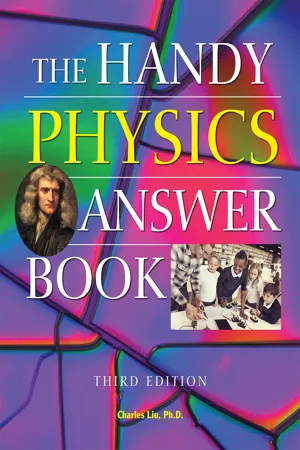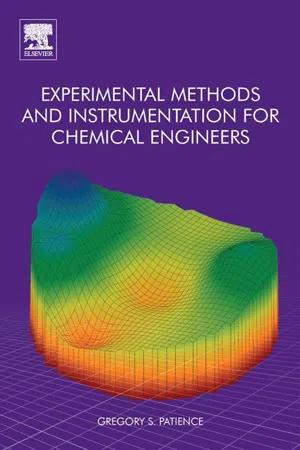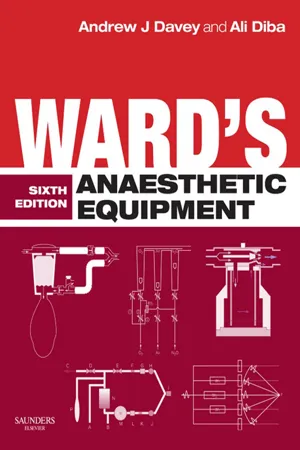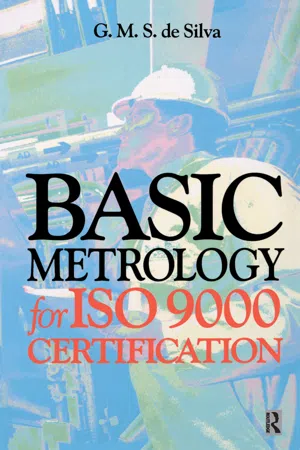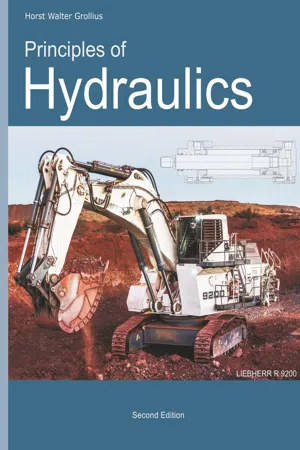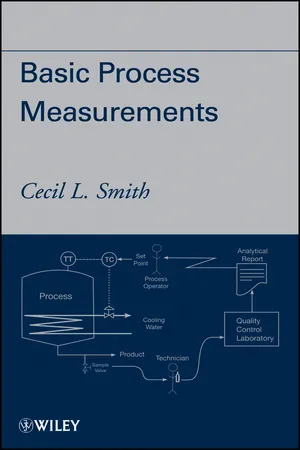Physics
Pressure
Pressure is the force applied perpendicular to the surface of an object per unit area. It is a measure of how much force is distributed over a given area and is calculated by dividing the force applied by the area over which it is distributed. In physics, pressure is a fundamental concept used to describe various phenomena, such as fluid dynamics and mechanical systems.
Written by Perlego with AI-assistance
Related key terms
Related key terms
1 of 4
Related key terms
1 of 3
11 Key excerpts on "Pressure"
- eBook - ePub
- John Bird(Author)
- 2019(Publication Date)
- Routledge(Publisher)
Chapter 29 Pressure in fluidsWhy it is important to understand: Pressure in fluidsThis chapter describes fluid Pressure and also defines Archimedes’ Principle, which is used to determine the buoyancy of boats, yachts, ships, etc. The chapter also describe gauges used in fluid mechanics, such as barometers, manometers, the Bourdon Pressure gauge, and vacuum gauges. These gauges are used to determine the properties and behaviour of fluids when they are met in practice. Knowledge of hydrostatics is of importance in boats, ships and other floating bodies and structures.At the end of this chapter, you should be able to:- define Pressure and state its unit
- understand Pressure in fluids
- distinguish between atmospheric, absolute and gauge Pressures
- state and apply Archimedes’ principle
- describe the construction and principle of operation of different types of barometer
- describe the construction and principle of operation of different types of manometer
- describe the construction and principle of operation of the Bourdon Pressure gauge
- describe the construction and principle of operation of different types of vacuum gauge
29.1 Pressure
The Pressure acting on a surface is defined as the perpendicular force per unit area of surface. The unit of Pressure is thepascal* , Pawhere 1 pascal is equal to 1 newton per square metre. Thus Pressure,p =F Apascalswhere F is the force in newtons acting at right-angles to a surface of area A square metres.When a force of 20 N acts uniformly over, and perpendicular to, an area of 4 m2 , then the Pressure on the area p is given by:p == 5 P a2 0 N4m 2It should be noted that for irregular shaped flat surfaces, such as the water planes of ships, their areas can be calculated using the mid-ordinaterule, described in chapter 21 .Science and Mathematics for Engineering. 978-0-367-2O475-4, © John Bird. Published by Taylor & Francis. All rights reserved. - eBook - ePub
- Charles Liu(Author)
- 2020(Publication Date)
- Visible Ink Press(Publisher)
FLUIDS
What is a fluid?
Solid objects retain their shape because strong forces hold the atoms in their places. In a liquid, the forces keep the atoms close together, but they are free to move. In a gas, the atoms are about ten times farther apart than in either solids or liquids, and forces between them are very weak. As a result of weaker forces, a liquid or gas can flow freely and assume the shape of its container. Both liquids and gases are called fluids. The study of fluids in a state of rest (static fluids) or in motion is called fluid mechanics, and the study of the movement of fluids is called fluid dynamics.WATER Pressure
What is Pressure?
Pressure is a measure of force exerted divided by the area over which it is exerted. You can exert Pressure, for example, by pressing your hand against a surface, like a table or wall. You feel water Pressure when you go into a swimming pool. Your body is experiencing air Pressure all the time, although you might not feel it. One very important physical principle is that any volume of liquid, such as water, exerts equal Pressure in all directions.What is Pascal’s Principle, and how does it work?
In 1647 the French scientist Blaise Pascal (1623–1662) recognized that liquids, like water, exert the same Pressure in all directions. This statement is known as Pascal’s Principle.To understand Pascal’s Principle, think of a small cube of water, as shown in Figure 12 . The gray arrow in the middle is the force of gravity on the cube. As a result of gravity, the total downward force of the cube is larger than the upward force.Now by Newton’s Third Law, the outward force of the water is equal to the inward force on the water. What exerts this force on the water? If the cube is at the edge of the container, then the container exerts the force. You can check that for yourself. Use an empty fluid container—say a juice box or milk carton. Punch a hole in one side. Pour water into the container. To keep the water from leaving through the hole, you have to exert a force with your thumb. The same would be true if the hole were in the bottom. What exerts the downward force on the top of the cube? If the cube is not at the top surface, then the force is exerted by water above it. If it is on the top, then air Pressure exerts this force. - eBook - ePub
- P.K. Jayasree, K Balan, V Rani(Authors)
- 2021(Publication Date)
- CRC Press(Publisher)
12 Fluid Mechanics12.1 Pressure and Its Measurement
A fluid is a substance which deforms continuously under the action of shearing forces. That is, if a fluid is at rest, there can be no shearing forces acting, and therefore, all forces in the fluid must be perpendicular to the planes upon which they act.Pressure is the measure of a force on a specified area. However, depending on the application, there can be many different ways of interpreting Pressure.12.1.1 Pressure Terminology
- Absolute Pressure (Figure 12.1 ) is measured relative to absolute zero on the Pressure scale, which is a perfect vacuum. (Absolute Pressure can never be negative.) Absolute Pressure is indicated by p and is identical to the familiar thermodynamic Pressure.FIGURE 12.1 Pressure terminology.
- Gauge Pressure (Figure 12.1 ) is measured relative to the local atmospheric Pressure. Gauge Pressure is thus zero when the Pressure is the same as atmospheric Pressure. (It is possible to have negative gauge Pressure.) Gauge Pressure is indicated bypgand is related to absolute Pressure as follows:pg= p −pa, wherepais the local atmospheric Pressure.
- Vacuum Pressure (Figure 12.1 ) is also measured relative to the local atmospheric Pressure, but is used when the gauge Pressure is negative, i.e., when the absolute Pressure falls below the local atmospheric Pressure. (Positive vacuum Pressure means that the gauge Pressure is negative.) Vacuum Pressure is indicated bypvacuumand is related to absolute Pressure as follows:pvacuum=pa− p , wherepais the local atmospheric Pressure.
- Differential Pressure is the Pressure difference between two media. Although most gauge Pressures are technically a differential Pressure sensor—measuring the difference between the medium and atmospheric Pressure. A true differential Pressure sensor is used to identify the difference between the two separate physical areas. For example, differential Pressure is used to check the Pressure drop—or loss—from one side of an object to the other.
- Gregory S. Patience(Author)
- 2013(Publication Date)
- Elsevier(Publisher)
Pressure measurement is a critical factor not only in the oil and gas industry but also for the operation of process equipment including reactors, distillation columns, pipelines, and for the measurement of flow rate. It is a scalar quantity and equals the perpendicular force exerted on a surface with the units of force per surface area:(4.1)Pressure together with temperature, flow rate, and concentration are the essential macroscopic properties required to operate chemical processes. Various units are frequently used to report Pressure and some common units and their conversions are reported in Table 4.2 .Table 4.1Antoine Constants of Various Compounds (T in °C, P in kPa)Table 4.2 Common Pressure Units and Their ConversionsAtmospheric Pressure is a result of the hydrostatic head of air and equals 101 325 Pa (at sea level and a clear day). However, the Aristotelian view was that air was weightless. It wasn’t until the Renaissance that Toricelli challenged this postulate. To avoid being accused of witchcraft and sorcery, he worked secretly and invented the mercury (“quicksilver”) barometer to conduct experiments in an instrument measuring only 80 cm in height compared to a water column of over 10 m that was commonly used at the time. Pascal was the first to demonstrate that Pressure changed with elevation by measuring the height of mercury in a barometer at the base of the Puy de Dome and along its height to the summit at 1464 m.Together with columns of liquids, other forms of Pressure common to the process industry include the Pressure of gases in vessels, vapor Pressure, dynamic Pressure, and Pressure drop across pipes, flow meters and through porous materials. At constant Pressure and a fixed mass, Boyle’s law states that for an ideal gas, the volume and absolute Pressure are inversely proportional:(4.2)or(4.3)As the Pressure of an ideal gas increases, its volume decreases proportionately. Charles’ law describes the relationship between the volume and temperature of an ideal gas at constant Pressure:(4.4)The volume increases proportionally with temperature. Amontons’ law relates Pressure and temperature and can be derived from Boyle’s and Charles’ laws:- eBook - ePub
Ward's Anaesthetic Equipment
Ward's Anaesthetic Equipment E-Book
- Andrew J Davey, Ali Diba(Authors)
- 2012(Publication Date)
- Saunders(Publisher)
2 Measurement of Pressure and gas flowPaul BeattyChapter contentsForce, Pressure and flow Atmospheric Pressure and partial Pressure Absolute, differential and gauge Pressures Methods of measuring Pressure Measurement of gas flowAny system for delivering anaesthetic gasses requires the consistent and accurate measurement of gas flow and Pressure. In order to be able to understand the detailed design of modern anaesthetic machines, this chapter will consider how such measurements are obtained and the basic physical principles involved.Force, Pressure and flow
Force is that which causes an object to move or, more accurately, to accelerate. Once it is moving, Newton’s Laws tell us that it will continue to move in a straight line at a constant rate unless some other force is applied to it. The SI unit of force is the Newton (N) , which is defined as the force that causes a mass of 1 kg to accelerate by 1 metre per second per second (m s−2 ). Other units of force occasionally used are the kilogram force (kgf) and the pound force (lbf). These are forces equivalent to the force exerted by the earth’s gravity on masses of a kilogram and a pound, respectively.Pressure is force per unit area over which the force acts, i.e.In any gas or liquid, Pressure acts in all directions equally, whereas force acts in a given direction. For example, in a full hypodermic syringe, the liquid can be pressurized by applying a force to the plunger of the syringe. This is applied in the direction of travel of the plunger. However, if there were a leak in the barrel of the syringe, the liquid would squirt out sideways from the leak, as well as from the syringe outlet (Fig. 2.1 - eBook - ePub
Making Physics Fun
Key Concepts, Classroom Activities, and Everyday Examples, Grades K?8
- Robert Prigo(Author)
- 2015(Publication Date)
- Skyhorse(Publisher)
3 Pa. It should be mentioned that a common practice is to discuss the “Pressure of a gas” even without reference to an object placed within the gas or to the walls of the container. But to measure the Pressure, an object must be immersed in the gas (a Pressure gauge, for example).If the gas is atmospheric air, the gas Pressure is often called the atmospheric Pressure or barometric Pressure. Under normal conditions, the atmospheric Pressure at the surface of the earth is a little less than 15 pounds per square inch (15 psi). This Pressure varies a little from day to day, depending on the comings and goings of weather fronts. It also varies with elevation, with the Pressure decreasing as one ascends through the thinning and colder atmosphere. It is important to realize that 15 psi is a very large Pressure. To see this, consider a 10”-by-10” piece of paper sitting on your desk. Bathed in the atmosphere, this piece of paper experiences about 1500 pounds of force on each of its sides! In this case, as in most cases, the atmospheric Pressure is the same on all sides of an object, so the object feels no net force due to this Pressure. In other words, in most cases, we do not even notice this large Pressure. Only when the equilibrium is changed and one part of an object experiences a different Pressure from some other part will a net force result. If no other forces are balancing this Pressure difference, the object will move (accelerate).In order to discover the factors that determine the magnitude of the Pressure of a gas, consider a container of gas, say, a can filled with air. Surely the number of molecules in the gas is important. It makes sense that if more molecules were added to the can that the Pressure would increase, or if some molecules were removed from the can that the Pressure would decrease. A molecular argument would reason that if more molecules were added to the can, without any changes in the molecular speeds (temperature) and the size of the can (volume), there would be more collisions per second - eBook - ePub
- British Gas(Author)
- 2014(Publication Date)
- Routledge(Publisher)
5 ). Fluid Pressure has two important characteristics:— At any point within the fluid, the Pressure is the same in all directions.— The Pressure on the inside walls of the fluid container always acts at right angles to the wall surface.Absolute and atmospheric Pressure
The Pressure within a complete vacuum is zero and this is the starting point of the absolute or total Pressure scale. This is demonstrable from the definition of Pressure as force per unit area:from Equation 4.1 ,If mass (m) is zero as in a total vacuum, there must obviously be zero Pressure.Consider Figure 4.4 , which shows diagrammatically a cross-section through the Earth’s atmosphere.Fig. 4.4At point X at sea level on the Earth’s surface, the total mass of a column of 1 m2 cross-section extending right through the atmosphere is about 10 200 kg. Using Equation 4.10 :(Illustrative calculation only; no account taken of the centrifugal force of the Earth’s rotation). This Pressure is atmospheric or barometric or ambient Pressure (pamb ) and is the most widely known example of Pressure quoted in absolute terms. It varies according to meteorological conditions and is measured by barometer, a Pressure gauge which takes a differential measurement against vacuum i.e. zero absolute Pressure. It also varies by location, because the Earth is not a perfect sphere and g is not therefore uniformly 9.81 at sea level.It will be evident from the above that atmospheric Pressure decreases with height above the Earth’s surface as the height and hence mass of the atmosphere above the reference point becomes less, the effect being enhanced by reducing air density and hence the relationship is not linear. Figure 4.5 shows the percentage reduction of atmospheric Pressure at heights of up to 5 km above sea level.Fig. 4.5 Variation of Barometric Pressure with Altitude - eBook - ePub
- G. M. S. de Silva(Author)
- 2012(Publication Date)
- Routledge(Publisher)
5 Pressure measurements 5.1 Introduction Pressure is one of the most important and widely measured quantities in industry. Accurate and traceable Pressure measurement is important in many sectors, e.g. health, meteorology, transport, power. A variety of instruments are used for measurement of Pressure and the basic operating principles of some of these instruments together with guidelines for their calibration are given in this chapter. 5.2 SI and other units The SI unit for measurement of Pressure is the newton (N) per square metre (m 2), having the special name pascal (Pa). The pascal is comparatively small in magnitude and therefore for most practical measurements decimal multiples kilopascal, megapascal and gigapascal are used. The other metric units commonly used for measurement of Pressure are the bar, the kilogram-force per square centimetre, and millimetre of mercury. However, the use of the latter unit is strongly discouraged due to its inadequate definition. A popular non-metric unit for measurement of Pressure is the pound-force per square inch (lbf/in 2). In both metric and non-metric systems, sometimes Pressures are erroneously indicated in mass units, e.g. ‘200 PSI’, which should correctly be written as ‘200 pound-force per square inch’ or ‘200 lbf/in 2 ’. The definitions, symbols and conversion factors of Pressure units are given in Table 5.1. The manometric units millimetre of mercury and inch of water depend on an assumed liquid density and acceleration due to gravity. Both of these assumptions inherently limit their relationship to the pascal. The use of these units, though given in the above table for sake of completeness, is strongly discouraged internationally - eBook - ePub
- Horst Walter Grollius(Author)
- 2017(Publication Date)
- Books on Demand(Publisher)
2 Physical Principles2.1 Pressure Definition, Absolute Pressure, OverPressure, Pressure Units
For the explanation of the Pressure definition a volume section from a fluid shall be considered as shown in Figure 2.1 .Figure 2.1: For the explanation of the Pressure definitionThe characteristic fluid point O is equal to a point located on the surface of the part fluid (Figure 2.1 ). At point O the surface element dA is situated, where the force dF is acting vertically. The Pressure p is the quotient of dF and dA :The Pressure value is independent of the cutting sectional plane direction touching point O . That means the Pressure is a scalar physical quantity; its numerical value depends only on the place in the fluid.Below, the terms absolute Pressure and overPressure (= Pressure measured relative to atmospheric Pressure) will be explained based on Figure 2.2 .Figure 2.2: Absolute Pressure scale and overPressure scaleThe absolute Pressure scale (upper scale in Figure 2.2 ) starts at p abs = 0 (Pressure at vacuum). The difference between the absolute Pressure p abs and the local (absolute) atmospheric Pressure p amb is the atmospheric Pressure difference:This Pressure difference is called overPressure (or gauge Pressure ).If the absolute Pressure p abs is higher than the local (absolute) atmospheric Pressure p amb the overPressure became positive valueIf the absolut Pressure p abs is lower than the actual (absolute) atmospheric Pressure p amb the overPressure became negative valueThe minimal (theoretical) overPressure value p e,min is determined by the actual (absolute) atmospheric Pressure p amb . For example, if there is a Pressure with p amb =1,05bar as shown in Figure 2.2 the minimal overPressure value isThe example shows: The numerical value of the minimal overPressure value is depending on the actual (absolute) atmospheric Pressure value p amb .NOTE: Often the indices “abs” and “e” are omitted for clear identification of absolute Pressure and overPressure. From the context it is to find out whether absolute Pressure or overPressure is of importance. - eBook - ePub
- Walt Boyes(Author)
- 2009(Publication Date)
- Butterworth-Heinemann(Publisher)
Chapter 14. Measurement of PressureE.H. Higham and J.M. Paros
14.1. What is Pressure?
When a fluid is in contact with a boundary, it produces a force at right angles to that boundary. The force per unit area is called the Pressure. In the past, the distinction between mass and force has been blurred because we live in an environment in which every object is subjected to gravity and is accelerated toward the center of the earth unless restrained. As explained in Chapter 8 , the confusion is avoided in the SI system of units (Systeme International d'Unités), where the unit of force is the Newton and the unit of area is a square meter, so that Pressure, being force per unit area, is measured in Newtons per square meter and the unit, known as the Pascal, is independent of the acceleration due to gravity.The relation between the Pascal and other units used for Pressure measurements is shown in Table 14.1 .TABLE 14.1. Pressure measurementsPascal (Pa) Bar (bar) Millibar (mbar) Standard atmosphere (atm) Kilogram force per square cm (kgf/cm 2 ) Pound force per square inch (Ibf/in 2 ) Torr Millimeter of water (mmH 2 )O Millimeter of mercury (mmHg) Inch of water (inH 2 O) Inch of mercury (inHg) Pa 1 10 −5 10 −2 9.86923 × 10 1.01972 × 10 −5 1.45038 × 10 −4 7.50062 × 10 −3 1.01972 × 10 −1 7.50062 × 10 −3 4.01463 × 10 −3 2.95300 × 10 −4 bar 10 5 1 10 3 9.86923 × 10 −1 1.01972 14.5038 7.50062 × 10 −2 1.01972 × 10 −2 7.50062 × 10 −2 4.0163 × 10 −8 29.5300 mbar 10 2 10 −3 1 9.86923 × 10 −4 1.01972 × 10 −3 1.45038 × 10 −2 7.50062 × 10 −1 1.01972 × 10 7.50062 × 10 −5 4.01462 × 10 −1 2.95300 × 10 −2 atm 1.01325 × 10 5 1.01325 1.01325 × 10 3 1 1.03323 1.46959 × 10 7.60000 × 10 2 1.03323 × 10 5 760 4.06783 × 10 2 29.9213 kgf/cm 2 98066.5 0.980665 980665 0.967841 1 14.2233 735.559 × 10 2 - eBook - ePub
- Cecil L. Smith(Author)
- 2011(Publication Date)
- Wiley-AIChE(Publisher)
CHAPTER 3 Pressure Applications requiring the measurement of process Pressure include the following:- Many Pressure processes perform most efficiently at the highest Pressure permitted by the process equipment. Based on a measurement of the process Pressure, constraint control logic can maintain the process operating conditions close to the upper Pressure limit.
- Some chemical reactors operate at high vacuum (an absolute Pressure measurement), whereas others operate either just above atmospheric Pressure (no air leaks in) or just below atmospheric Pressure (no chemicals leak out).
- Towers and columns must be operated so that the Pressure drop across each section (packed or trays) is less than the maximum allowable Pressure drop to avoid flooding.
Level . About 75% of the level measurements rely on Pressure or differential Pressure measurements of the liquid head.Flow . Orifice and other head-type flow meters require a measurement of the differential Pressure. Orifice meter installations in the chemical industry are on the decline, but other industries continue to rely on the orifice meter as their flow meter of choice. In either case, the installed base is quite large.Physical properties . Density and viscosity measurements are often based on Pressure or differential Pressure.3.1. FORCE AND Pressure Over the centuries, the understanding of force was a key component of the advancement of science. Sir Isaac Newton was a key contributor:Gravitational force . Two objects attract each other with a force that is proportional to their masses and inversely proportional to the square of the distance between them.Acceleration
Index pages curate the most relevant extracts from our library of academic textbooks. They’ve been created using an in-house natural language model (NLM), each adding context and meaning to key research topics.
Explore more topic indexes
Explore more topic indexes
1 of 6
Explore more topic indexes
1 of 4

